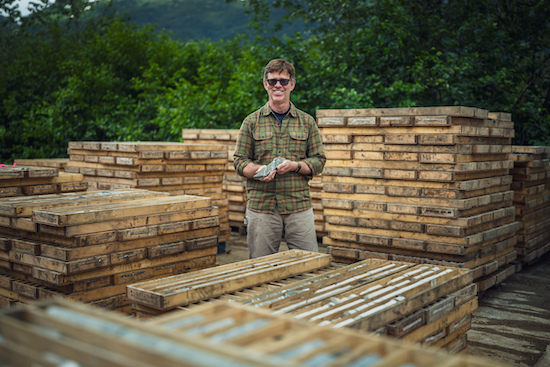Some of the best exploration stories are hidden gems. Others just seem to be hiding in plain sight.
|
Count Canagold Resources (CCM.TO; CRCUF.OTC) as firmly in the hiding in plain sight camp.
|
In a bullish market for gold, it seems odd that a company whose New Polaris project contains one of Canada’s highest-grade undeveloped gold deposits would escape the market’s attention.
But it has…until now.
|
That’s because, in a market set to begin attracting generalist investors in droves, Canagold’s days of flying below the radar are numbered.
You see, at this very moment, the drills are turning at New Polaris as part of an aggressive program to upgrade the current deposit and, as you’re about to discover, extend it at depth.
|
 |
| Canagold’s VP of Exploration Troy Gill holds a core sample from recent drilling at New Polaris that grades an astonishing 50.1 g/t over 0.8 meters. |
It’s that deeper drilling that could put Canagold on the map.
Given the mesothermal mineralization style New Polaris shares with some of the world’s richest deposits, these holes could dramatically expand its already large, million-ounce resource.
Those results are due in the weeks just ahead, providing the most immediate of a handful of reasons to consider adding Canagold Resources to your portfolio in the near future.
|
Canada’s Highest-Grade Deposits
|
It starts with the high-grade nature of the deposit at New Polaris, which sits in British Columbia’s northwest corner.
The historic underground mine at New Polaris produced 232,000 ounces of gold between 1938 and 1942 and between 1946 and 1951.
It’s been through a variety of operators since then, with Canarc Resources (Canagold’s old name) acquiring the project in 1992.
Canarc went on to outline a million-ounce resource (586,000 ounces indicated at 10.8 g/t and 485,000 ounces inferred at 10.2 g/t) below the mined-out area at New Polaris. Notably, those resources already factor in a 20% mining dilution rate.
|
And even more notably…those grades make the deposit one of the richest in Canada, if not the world.
|
The challenge it faced was how to process and transport that gold, given the difficult shipping conditions in the area — the Tulsequah River that flows by the mine is only partially navigable.
Save
Not A Subscriber Yet?
Get Golden Opportunities For Free
Subscribe to our Golden Opportunities e-letter to receive timely market
updates from the Gold Newsletter research team, plus video
presentations by expert speakers from the New Orleans Conference
— and the Investor’s Guide to Gold and Silver — all at no cost!
CLICK HERE to start your subscription.
|
Discovered:
The Golden Key To Unlock Value
|
Thus, the key to unlocking the treasure trove at New Polaris was to develop a process that could produce gold-rich “dore” bars that Canagold could cost-effectively fly for shipment.
|
| |
| A May 2020 PEA shows Canagold can profitably produce dore bars at New Polaris and then use this on-site airstrip to transport them for sale. |
Canagold landed on just such a process in the late 1990s and applied it to a 2019 preliminary economic analysis on New Polaris (updated in May 2020) that showed impressive economics.
The numbers speak for themselves.
|
The project has a post-tax NPV, discounted at 5%, of US$333 million, or more than nine times Canagold’s current market cap. After-tax IRR is a robust 56% and payback a rapid 1.9 years.
|
But here’s where New Polaris’s “hiding in plain sight” quality reared its head...with the market completely missing the implications of this PEA and Canagold’s strategy to very profitably mine this rich gold resource.
|
|
Fortunately, the aggressive, 47-hole drill program now underway at the project promises to jog the market’s memory.
That program has already generated assays as much as 2.5 times the average grade of the resources at New Polaris.
|
The latest results from this program were eye-popping (e.g., 30.8 g/t over 3.9 meters, 16.0 g/t over 1.5 meters and 11.6 g/t over 5.1 meters).
|
These infill results, with tighter drillhole spacing, will help Canagold prove up the current resource into higher confidence categories in advance of a feasibility study on New Polaris.
Those are high-grade results to be sure, and with almost 40 holes left to drill and assay, Canagold should pepper the market with high-grade assays through the end of the year.
But it’s two upcoming deep holes that could be the big market-mover for Canagold. The graphic below of Canada’s major mesothermal deposits shows why.
|
| |
| Canada’s mesothermal deposits have produced tens of millions of ounces of gold and typically extend much deeper than New Polaris’s current 600 meters. |
Canada’s other major mesothermal gold deposits lie within Ontario and Quebec’s portion of the Canadian Shield and include storied names like Red Lake, Hemlo, Timmins and Kirkland Lake.
As you can see from the graphic, the high-grade gold in these deposits goes deep — kilometers-deep in many cases.
|
By comparison, the deposit at New Polaris currently extends to just 600 meters, and the company is just about to drill two holes up to 200 meters below that level.
|
If the mineralization follows the pattern of these other mesothermal deposits, the assays from these drill holes could lead to a dramatic increase in the project’s resources...and show the market its dramatic, untapped potential.
|
|
With Canagold due to start drilling those holes later this month, a potentially explosive share price catalyst lies directly ahead.
All the while, that infill program will deliver reminders every two-to-three weeks of the high-grade nature of this deposit.
|
It’s a torrid pace of news that’s likely to wake the market up to the high-grade story at New Polaris and its impressive economics.
|
Add it all up, and Canagold’s current trading levels could soon prove to be a bargain investors will kick themselves for if they miss it.
|
|